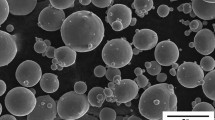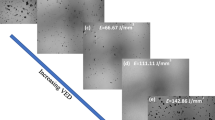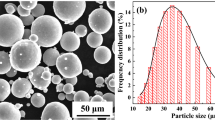Abstract
Enhanced levels of alloy print defects such as porosity are associated with the printing of overhang structures by laser powder bed fusion (L-PBF). This study compared the microstructure and porosity of Ti-6Al-4V overhang structures, with that observed for the bulk alloy. It was observed in the region around the overhang structure that the microstructure exhibited larger grain sizes and was less homogenous, compared to the that obtained within the bulk alloy. An increased level of porosity of up to 0.08% was also observed in the overhang print alloy, compared with the corresponding < 0.02% in the alloy bulk. It is hypothesised that these microstructural changes are associated with the excess heat generated in the overhang region, due to the decreased thermal conductivity of the powder immediately below the print layers, compared with solid alloy. During L-PBF alloy printing, in situ process monitoring of the melt pool emissions was obtained in the near-infrared range and correlated with the properties of the printed parts. This in-process data was used to assist in selecting optimal laser processing conditions, in order to help prevent melt pool overheating at the overhang. By systematically controlling the laser energy during the printing of the first fifteen layers over the overhang structure, the level of porosity was reduced, to the < 0.02% level of the bulk alloy. There was also an associated reduction in the roughness (Ra) of the overhang itself, with its Ra decreasing from 62.4 ± 7.3 to 7.5 ± 1.9 µm.














Similar content being viewed by others
References
Li J, Jin R, Hang ZY (2018) Integration of physically-based and data-driven approaches for thermal field prediction in additive manufacturing. Mater Des 139:473–485
Murr LE et al (2009) Microstructure and mechanical behavior of Ti–6Al–4V produced by rapid-layer manufacturing, for biomedical applications,". J Mech Behav Biomed Mater 2(1):20–32. https://doi.org/10.1016/j.jmbbm.2008.05.004
Liu R, Wang Z, Sparks T, Liou F, Newkirk J (2017) 13 - Aerospace applications of laser additive manufacturing, in laser additive manufacturing, M. Brandt Ed.: Woodhead Publishing, pp 351–371
Zhang S, Li J, Kou H, Yang J, Yang G, Wang J (2016) Effects of thermal history on the microstructure evolution of Ti-6Al-4V during solidification,". J Mater Process Technol 227:281–287. https://doi.org/10.1016/j.jmatprotec.2015.08.030
Kelly S, Kampe S (2004) Microstructural evolution in laser-deposited multilayer Ti-6Al-4V builds: part I. Microstructural characterization. Metall and Mater Trans A 35(6):1861–1867
Cao S, Zou Y, Lim CVS, Wu X (2021) Review of laser powder bed fusion (LPBF) fabricated Ti-6Al-4V: process, post-process treatment, microstructure, and property. Light: Adv Manuf 2(3):313–332
Li J, Zhou X, Brochu M, Provatas N, Zhao YF (2020) Solidification microstructure simulation of Ti-6Al-4V in metal additive manufacturing: a review. Additive Manufacturing 31:100989. https://doi.org/10.1016/j.addma.2019.100989
Kaschel FR, Celikin M, Dowling DP (2020) Effects of laser power on geometry, microstructure and mechanical properties of printed Ti-6Al-4V parts. J Mater Process Technol 278:116539. https://doi.org/10.1016/j.jmatprotec.2019.116539
Galarraga H, Warren RJ, Lados DA, Dehoff RR, Kirka MM, Nandwana P (2017) Effects of heat treatments on microstructure and properties of Ti-6Al-4V ELI alloy fabricated by electron beam melting (EBM). Mater Sci Eng, A 685:417–428
Kaschel F, Vijayaraghavan R, McNally PJ, Dowling DP, Celikin M (2021) In-situ XRD study on the effects of stress relaxation and phase transformation heat treatments on mechanical and microstructural behaviour of additively manufactured Ti-6Al-4V. Mater Sci Eng, A 819:141534
Gong H, Rafi K, Gu H, Starr T, Stucker B (2014) Analysis of defect generation in Ti–6Al–4V parts made using powder bed fusion additive manufacturing processes. Addit Manuf 1:87–98
Sola A, Nouri A (2019) Microstructural porosity in additive manufacturing: the formation and detection of pores in metal parts fabricated by powder bed fusion. J Adv Manuf Process 1(3):e10021
Kasperovich G, Haubrich J, Gussone J, Requena G (2016) Correlation between porosity and processing parameters in TiAl6V4 produced by selective laser melting. Mater Des 105:160–170
Rahmati S, Vahabli E (2015) Evaluation of analytical modeling for improvement of surface roughness of FDM test part using measurement results. Int J Adv Manuf Technol 79(5):823–829
Qiu C, Panwisawas C, Ward M, Basoalto HC, Brooks JW, Attallah MM (2015) On the role of melt flow into the surface structure and porosity development during selective laser melting. Acta Mater 96:72–79
Gockel J, Sheridan L, Koerper B, Whip B (2019) The influence of additive manufacturing processing parameters on surface roughness and fatigue life,". Int J Fatigue 124:380–388. https://doi.org/10.1016/j.ijfatigue.2019.03.025
Wang D, Yang Y, Yi Z, Su X (2013) Research on the fabricating quality optimization of the overhanging surface in SLM process. Int J Adv Manuf Technol 65(9):1471–1484
Lee Y, Zhang W (2015) Mesoscopic simulation of heat transfer and fluid flow in laser powder bed additive manufacturing. In 2015 International Solid Freeform Fabrication Symposium, University of Texas at Austin
Xiao X, Lu C, Fu Y, Ye X, Song L (2021) Progress on experimental study of melt pool flow dynamics in laser material processing. In Liquid Metals: IntechOpen
Fabbro R, Hirano K, Pang S (2016) Analysis of the physical processes occurring during deep penetration laser welding under reduced pressure. J Laser Appl 28(2):022427
Ashby A et al (2022) Thermal history and high-speed optical imaging of overhang structures during laser powder bed fusion: a computational and experimental analysis. Additive Manufacturing 53:102669. https://doi.org/10.1016/j.addma.2022.102669
Han Q, Gu H, Soe S, Setchi R, Lacan F, Hill J (2018) Manufacturability of AlSi10Mg overhang structures fabricated by laser powder bed fusion,". Materials & Design 160:1080–1095. https://doi.org/10.1016/j.matdes.2018.10.043
Clijsters S, Craeghs T, Buls S, Kempen K, Kruth J-P (2014) In situ quality control of the selective laser melting process using a high-speed, real-time melt pool monitoring system. Int J Adv Manuf Technol 75:1089–1101
Craeghs T, Clijsters S, Kruth JP, Bechmann F, Ebert MC (2012) Detection of process failures in layerwise laser melting with optical process monitoring. Physics Procedia 39:753–759. https://doi.org/10.1016/j.phpro.2012.10.097
Egan DS, Jones K, Dowling DP (2020) Selective laser melting of Ti-6Al-4V: comparing μCT with in-situ process monitoring data. CIRP J Manuf Sci Technol 31:91–98. https://doi.org/10.1016/j.cirpj.2020.10.004
Lough CS et al (2022) Local prediction of laser powder bed fusion porosity by short-wave infrared imaging thermal feature porosity probability maps. J Mater Process Technol 302:117473. https://doi.org/10.1016/j.jmatprotec.2021.117473
Alberts D, Schwarze D, Witt G (2017) In situ melt pool monitoring and the correlation to part density of Inconel® 718 for quality assurance in selective laser melting, in 2017 International Solid Freeform Fabrication Symposium, University of Texas at Austin
Berumen S, Bechmann F, Lindner S, Kruth J-P, Craeghs T (2010) Quality control of laser-and powder bed-based additive manufacturing (AM) technologies. Phys Procedia 5:617–622
Scime L, Beuth J (2019) Using machine learning to identify in-situ melt pool signatures indicative of flaw formation in a laser powder bed fusion additive manufacturing process. Additive Manufacturing 25:151–165. https://doi.org/10.1016/j.addma.2018.11.010
Renishaw-PLC. "Ti6Al4V ELI-0406 powder for additive manufacturing." Renishaw PLC. https://www.google.com/url?sa=t&rct=j&q=&esrc=s&source=web&cd=&ved=2ahUKEwjmgMfwx738AhURXcAKHe4yC4EQFnoECA8QAQ&url=https%3A%2F%2Fwww.renishaw.com%2Fmedia%2Fpdf%2Fen%2Fada9ffdf8ade44dbb9adb06ff5a74bbf.pdf&usg=AOvVaw0S_Vk-wSkxybSRHT8X58AV. Accessed 10 Jan 2023
Renishaw PLC (2018) InfiniAM spectral-energy input and melt pool emissions monitoring for AM systems, Data Sheet. http://resources.renishaw.com/en/details/data-sheet-renam-500q--99032
Egan DS, Dowling DP (2020) Correlating in-situ process monitoring data with the reduction in load bearing capacity of selective laser melted Ti–6Al–4V porous biomaterials. J Mech Behav Biomed Mater 106:103723
Repossini G, Laguzza V, Grasso M, Colosimo BM (2017) On the use of spatter signature for in-situ monitoring of laser powder bed fusion. Addit Manuf 16:35–48
Waygate Technologies (2021) Phoenix nanotom M 180 kV/ 20 W X-ray nano CT system for high-resolution analysis and 3D metrology. https://dam.bakerhughes.com/m/7f0e657b1ba8a63f/original/WT-31344en_nanotom_m_0517-pdf.pdf
VGStudio, "Porosity/inclusion analysis with VGDefX", 2020. https://www.volumegraphics.com/en/products/vgstudio-max/add-on-modules-for-material-analyses.html (accessed Jun. 11, 2022)
Kerckhofs G, Pyka G, Moesen M, Schrooten J, Wevers M (2012) High-resolution micro-CT as a tool for 3D surface roughness measurement of 3D additive manufactured porous structures, in Proc iCT, pp 77–83
Arola D, Ramulu M (1999) An examination of the effects from surface texture on the strength of fiber reinforced plastics. J Compos Mater 33(2):102–123
Greitemeier D, Dalle Donne C, Syassen F, Eufinger J, Melz T (2016) Effect of surface roughness on fatigue performance of additive manufactured Ti–6Al–4V. Materials Science and Technology 32(7):629–634
Geometrical product specifications (GPS) (2021) surface texture: profile - part 2: terms, definitions and surface texture parameters, ISO 21920-2:2021, International Organization for Standardization, Geneva
Taylor B, Weidmann E "Metallographic preparation of titanium". Struers. https://www.struers.com/-/media/Struers-media-library/Materials/Application-reports/Application_Note_Titanium_2015_ENG.pdf. Accessed 27 Jul 2022
Vrancken B, Thijs L, Kruth J-P, Van Humbeeck J (2012) Heat treatment of Ti6Al4V produced by selective laser melting: microstructure and mechanical properties. J Alloys Compounds 541:177–185. https://doi.org/10.1016/j.jallcom.2012.07.022
Shrestha S, Chou K (2022) Formation of keyhole and lack of fusion pores during the laser powder bed fusion process. Manufacturing Letters 32:19–23
Xu J, Rong Y, Huang Y, Wang P, Wang C (2018) Keyhole-induced porosity formation during laser welding,". J Mater Process Technol 252:720–727. https://doi.org/10.1016/j.jmatprotec.2017.10.038
Gornakova A, Prokofjev S (2020) Energetics of intergranular and interphase boundaries in Ti–6Al–4V alloy. J Mater Sci 55:9225–9236
Lee S, Kim J, Choe J, Kim S-W, Hong J-K, Choi YS (2021) Understanding crack formation mechanisms of Ti–48Al–2Cr–2Nb single tracks during laser powder bed fusion. Met Mater Int 27:78–91
Tang M, Pistorius PC, Beuth JL (2017) Prediction of lack-of-fusion porosity for powder bed fusion,". Additive Manufacturing 14:39–48. https://doi.org/10.1016/j.addma.2016.12.001
Keaveney S, Shmeliov A, Nicolosi V, Dowling DP (2020) Investigation of process by-products during the selective laser melting of Ti6AL4V powder,". Additive Manufacturing 36:101514. https://doi.org/10.1016/j.addma.2020.101514
DebRoy T et al (2018) Additive manufacturing of metallic components – process, structure and properties. Progress in Materials Science 92:112–224. https://doi.org/10.1016/j.pmatsci.2017.10.001
Fox JC, Moylan SP, Lane BM (2016) Effect of process parameters on the surface roughness of overhanging structures in laser powder bed fusion additive manufacturing,". Procedia CIRP 45:131–134. https://doi.org/10.1016/j.procir.2016.02.347
Funding
This publication was produced from research supported in part by a research grant from Science Foundation Ireland (SFI) under Grant Number 16/RC/3872 and the SMART Eureka project APEM-AM. For the purpose of Open Access; the author has applied a CC by public copyright licence to any Author Accepted Manuscript version arising from this submission. The authors would also like to acknowledge the support provided by the Stryker European Operations Limited.
Author information
Authors and Affiliations
Contributions
JP: conceptualisation, writing—review and editing, writing—original draught, methodology, visualisation, and investigation. OH: conceptualisation, writing—review and editing, methodology, visualisation, and investigation. MH: conceptualisation, methodology, and resources. DE: conceptualisation and methodology. DP.D: conceptualisation, project administration, resources, and writing—review and editing.
Corresponding author
Ethics declarations
Competing interests
The authors declare no competing interests.
Additional information
Publisher's Note
Springer Nature remains neutral with regard to jurisdictional claims in published maps and institutional affiliations.
Rights and permissions
Springer Nature or its licensor (e.g. a society or other partner) holds exclusive rights to this article under a publishing agreement with the author(s) or other rightsholder(s); author self-archiving of the accepted manuscript version of this article is solely governed by the terms of such publishing agreement and applicable law.
About this article
Cite this article
Power, J.J., Humphreys, O., Hartnett, M. et al. Application of in situ process monitoring to optimise laser parameters during laser powder bed fusion printing of Ti-6Al-4V parts with overhang structures. Int J Adv Manuf Technol 130, 2297–2311 (2024). https://doi.org/10.1007/s00170-023-12794-z
Received:
Accepted:
Published:
Issue Date:
DOI: https://doi.org/10.1007/s00170-023-12794-z




